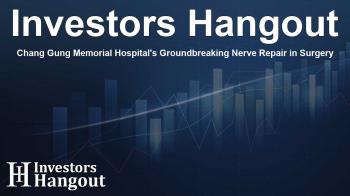Chang Gung Memorial Hospital's Groundbreaking Nerve Repair in Surgery

Chang Gung Memorial Hospital's Innovative Approach to Reconstruction
Chang Gung Memorial Hospital is stepping into a new era of medical innovation with their pioneering work in breast reconstruction. Their latest advancement, the autologous sensory nerve reconstruction technique, marks a significant milestone in restoring both appearance and sensation to patients who have undergone mastectomies due to breast cancer. This groundbreaking approach goes beyond just aesthetics; it seeks to rejuvenate the patient's sensory experience, allowing them to feel complete once more.
Understanding the Technique
The newly developed Breast Sensory Autologous Nerve Reconstruction Technique combines state-of-the-art microsurgery with the application of autologous nerves—nerves harvested from the patient's own body—in coordination with reconstructed breast tissue. This procedure addresses the common challenge of sensory loss faced by many breast cancer survivors. According to the hospital’s microsurgical reconstruction team, their use of sophisticated surgical methodologies has resulted in recovery processes that embrace natural feeling in reconstructed areas.
Milestone Achievements
With over 300 successful microsurgical procedures completed to date, Chang Gung has established itself as a leader in the realm of breast reconstruction. This significant achievement not only showcases the hospital's pioneering spirit but also highlights its commitment to enhancing patient outcomes and experiences.
Legacy of Excellence in Surgery
The Department of Plastic and Reconstructive Surgery at Chang Gung Memorial Hospital has gained international recognition since its founding 48 years ago by Dr. Samuel Noordhoff. The department has become renowned for its expertise in microsurgery and craniofacial reconstruction and is recognized as a center of excellence within the global medical community.
Training the Next Generation of Surgeons
In addition to its exceptional treatment capabilities, Chang Gung also serves as a prominent training facility for aspiring microsurgeons from around the world. The Microsurgical Reconstruction Center has been at the forefront of technological advancements, including the development of the interdisciplinary Da Vinci Xi robot-assisted reconstruction surgery.
Collaborative Surgical Innovations
The integration of specialized surgical teams at Chang Gung has led to innovative procedures such as sympathetic chain reconstruction and Da Vinci Xi-assisted breast sensory nerve reconstruction. This collaborative approach has allowed them to achieve remarkable international success in recent years.
Comprehensive Patient Care
At Chang Gung, comprehensive and personalized care remains a top priority. The hospital's dedication to advanced reconstructive solutions is complemented by the use of cutting-edge technologies, such as 3D printing. By utilizing sophisticated pre-operative modeling, the surgical team can create custom implants and surgical guides tailored to each patient’s unique anatomy.
Real Stories of Transformation
Stories of transformation and hope emerge from Chang Gung’s patients, many of whom have overcome life-altering challenges through innovative surgical techniques. For instance, Jim, a young man from the Middle East, suffered severe facial injuries in an accident and, after multiple surgeries elsewhere failed, found renewed hope at Chang Gung, where he achieved remarkable recovery. Similarly, Amy, who had endured multiple failed breast reconstructions in the United States, regained not only the physical appearance of her breasts but also the sensation—restoring her quality of life after receiving treatment at the facility.
Commitment to Patient-Centered Excellence
Chang Gung Memorial Hospital’s mission emphasizes the blend of world-class medical excellence with compassionate care. This unwavering commitment to empowering patients allows individuals to confront their challenges with renewed courage and hope, paving the way for a vibrant, fulfilling future post-surgery.
Frequently Asked Questions
What is the purpose of the Breast Sensory Autologous Nerve Reconstruction Technique?
This technique aims to restore both the physical appearance and sensory function of the breast after mastectomy, helping patients feel whole again.
How many procedures has Chang Gung Memorial Hospital completed using this technique?
The hospital has successfully performed over 300 microsurgical procedures in the field of breast reconstruction.
Who founded the Department of Plastic and Reconstructive Surgery?
The department was founded by Dr. Samuel Noordhoff 48 years ago and has since gained international acclaim.
How does Chang Gung incorporate technology in its surgical procedures?
The hospital utilizes 3D printing technology for creating personalized surgical guides and implants tailored to each patient’s unique needs.
What is the focus of the Chang Gung Craniofacial Center?
The center specializes in treating complex craniofacial conditions and is recognized as one of Asia's largest specialized medical institutions.
About The Author
Contact Ryan Hughes privately here. Or send an email with ATTN: Ryan Hughes as the subject to contact@investorshangout.com.
About Investors Hangout
Investors Hangout is a leading online stock forum for financial discussion and learning, offering a wide range of free tools and resources. It draws in traders of all levels, who exchange market knowledge, investigate trading tactics, and keep an eye on industry developments in real time. Featuring financial articles, stock message boards, quotes, charts, company profiles, and live news updates. Through cooperative learning and a wealth of informational resources, it helps users from novices creating their first portfolios to experts honing their techniques. Join Investors Hangout today: https://investorshangout.com/
The content of this article is based on factual, publicly available information and does not represent legal, financial, or investment advice. Investors Hangout does not offer financial advice, and the author is not a licensed financial advisor. Consult a qualified advisor before making any financial or investment decisions based on this article. This article should not be considered advice to purchase, sell, or hold any securities or other investments. If any of the material provided here is inaccurate, please contact us for corrections.

